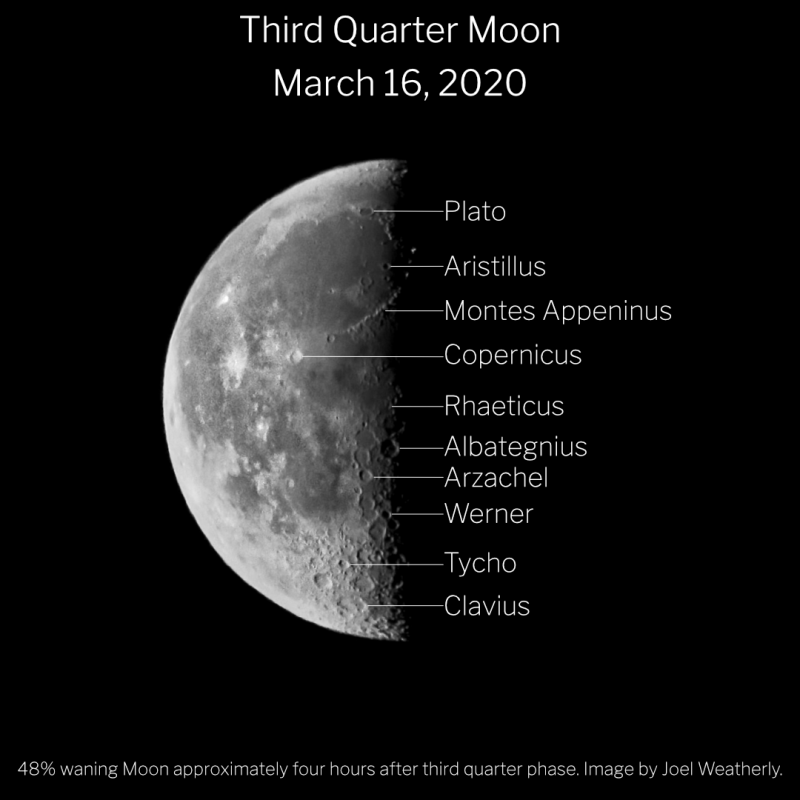
Before daybreak on May 14, 2020, look for the moon to be at or near its last quarter phase, and close to the red planet Mars.
Mars is respectably bright now and getting brighter. Still, you’ll want to get up early (an hour or more before sunrise) to view Mars in the predawn sky; it’ll fade from view as dawn is breaking. Excluding our sun, Mars presently ranks as the 8th-brightest “star” to light up the sky. Mars is no match for the king planet Jupiter, which is near it on the sky’s dome and which outshines Mars by nearly 12 times. Jupiter ranks as the 4th-brightest celestial body, after the sun, moon and the planet Venus, respectively.
Earth in its smaller, faster orbit is gaining ground on Jupiter and Mars daily. These planets, in turn, are both brightening in Earth’s sky day by day.
Some 5 months from now – On October 13, 2020 – the Earth will swing in between the sun and Mars, and Mars, in turn, will beam at its brightest best in Earth’s sky for the year. This event is called opposition by astronomers. On October 13, 2020, Mars will be a whopping 16 times brighter than it appears on May 14. In fact, from October 1 to 30, 2020, Mars will actually replace Jupiter as the 4th-brightest celestial object to light up the heavens, after the sun, moon and Venus, respectively.
By the way, Jupiter’s opposition will come only two months from now, on July 14, 2020. Then Jupiter will shine at its brightest in Earth’s sky for the year. On July 14, 2010, Jupiter will be about 1.2 times brighter than it appears on May 14, 2020.
Thus the brightness of Mars changes precipitously, while that of Jupiter remains close to constant. That’s because the percentage of change in the Earth/Mars distance is large whereas the percentage of change in the Earth/Jupiter distance remains rather small.

Here is Mars (left) not long after its last opposition in 2018. It was exceptionally bright that year! Joe Randall at Twin Lakes, Colorado caught the planet and the Milky Way during the Perseid meteor shower, August 12, 2018.
About the last quarter moon. Although the moon and Mars appear fairly close together on the sky’s dome, they are not particularly close together in space. The last quarter moon lodges about 247,000 miles (nearly 398,000 km) from Earth, while Mars lies way beyond the moon, at about 425 times the moon’s distance.
Although the last quarter moon occurs at the same instant for all of us worldwide (May 14 at 14:03 UTC), our clocks read differently by time zone. At United States time zones, the last quarter moon comes at 10:03 a.m. EDT, 9:03 a.m. CDT, 8:03 a.m. MDT, 7:03 a.m. PST, 6:03 a.m. AKDT and 4:03 am. HST. The last quarter phase will happen after sunrise May 14 for the most of the United States. As with all last quarter moons, this one will rise around midnight and appear highest in the sky around the time dawn breaks. You might still notice the half-lit quarter moon in a blue daytime sky, as morning progresses. It’ll set around midday. Read more about the last quarter moon.

View at EarthSky Community Photos. | Joel Weatherly in Edmonton, Aberta, Canada wrote on March 16, 2020: “I have been enjoying selenography lately, so here is this morning’s last quarter moon with labels for 10 features I found interesting. This image was captured about 4 hours after the moon exactly reached its last quarter phase.” Thank you, Joel!
Bottom line: On May 14, 2020, the moon is at or near its last quarter phase and close to the red planet Mars on the sky’s dome. Watch for the half-lit moon in the predawn sky; the red planet will be near it.
from EarthSky https://ift.tt/2YXNFCH

Before daybreak on May 14, 2020, look for the moon to be at or near its last quarter phase, and close to the red planet Mars.
Mars is respectably bright now and getting brighter. Still, you’ll want to get up early (an hour or more before sunrise) to view Mars in the predawn sky; it’ll fade from view as dawn is breaking. Excluding our sun, Mars presently ranks as the 8th-brightest “star” to light up the sky. Mars is no match for the king planet Jupiter, which is near it on the sky’s dome and which outshines Mars by nearly 12 times. Jupiter ranks as the 4th-brightest celestial body, after the sun, moon and the planet Venus, respectively.
Earth in its smaller, faster orbit is gaining ground on Jupiter and Mars daily. These planets, in turn, are both brightening in Earth’s sky day by day.
Some 5 months from now – On October 13, 2020 – the Earth will swing in between the sun and Mars, and Mars, in turn, will beam at its brightest best in Earth’s sky for the year. This event is called opposition by astronomers. On October 13, 2020, Mars will be a whopping 16 times brighter than it appears on May 14. In fact, from October 1 to 30, 2020, Mars will actually replace Jupiter as the 4th-brightest celestial object to light up the heavens, after the sun, moon and Venus, respectively.
By the way, Jupiter’s opposition will come only two months from now, on July 14, 2020. Then Jupiter will shine at its brightest in Earth’s sky for the year. On July 14, 2010, Jupiter will be about 1.2 times brighter than it appears on May 14, 2020.
Thus the brightness of Mars changes precipitously, while that of Jupiter remains close to constant. That’s because the percentage of change in the Earth/Mars distance is large whereas the percentage of change in the Earth/Jupiter distance remains rather small.

Here is Mars (left) not long after its last opposition in 2018. It was exceptionally bright that year! Joe Randall at Twin Lakes, Colorado caught the planet and the Milky Way during the Perseid meteor shower, August 12, 2018.
About the last quarter moon. Although the moon and Mars appear fairly close together on the sky’s dome, they are not particularly close together in space. The last quarter moon lodges about 247,000 miles (nearly 398,000 km) from Earth, while Mars lies way beyond the moon, at about 425 times the moon’s distance.
Although the last quarter moon occurs at the same instant for all of us worldwide (May 14 at 14:03 UTC), our clocks read differently by time zone. At United States time zones, the last quarter moon comes at 10:03 a.m. EDT, 9:03 a.m. CDT, 8:03 a.m. MDT, 7:03 a.m. PST, 6:03 a.m. AKDT and 4:03 am. HST. The last quarter phase will happen after sunrise May 14 for the most of the United States. As with all last quarter moons, this one will rise around midnight and appear highest in the sky around the time dawn breaks. You might still notice the half-lit quarter moon in a blue daytime sky, as morning progresses. It’ll set around midday. Read more about the last quarter moon.

View at EarthSky Community Photos. | Joel Weatherly in Edmonton, Aberta, Canada wrote on March 16, 2020: “I have been enjoying selenography lately, so here is this morning’s last quarter moon with labels for 10 features I found interesting. This image was captured about 4 hours after the moon exactly reached its last quarter phase.” Thank you, Joel!
Bottom line: On May 14, 2020, the moon is at or near its last quarter phase and close to the red planet Mars on the sky’s dome. Watch for the half-lit moon in the predawn sky; the red planet will be near it.
from EarthSky https://ift.tt/2YXNFCH

Aucun commentaire:
Enregistrer un commentaire